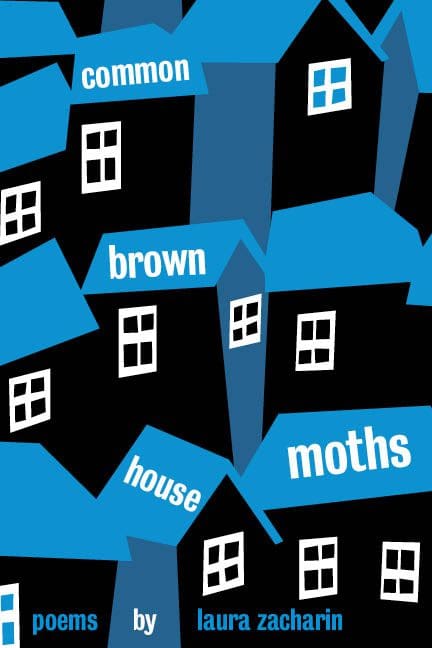Review: Common Brown House Moths by Laura Zacharin
Reviewed by Marguerite Pigeon

Pests lurk through the pages of Laura Zacharin’s assured first collection, including lice and the titular moths. Nagging, unsettling, preoccupying to the point of distraction, these domestic nuisances are symptomatic—but of what? An unnamed woman in the poem “Common Brown House Moths” can’t shake a dread that builds into physical distress.
… she
only wanted to talk about the moths. Do something! she kept saying. Get
rid of these moths. Call Pest Control. Then call again! That summer
was the hottest one on record in 63 years. The house was warm/
and muggy. The air was still. She could hardly breathe.
Sudden desperation. Fear bordering on violent constriction. Zacharin’s narrators are in the trenches of a bodily fight against unglamorous problems: infestation, yes, but also burnout, breakups, elder care, and empty-nest syndrome. Moving stylistically between the confessional, the fragmentary, and the surreal, Zacharin’s poems validate pesky realities of life that are sometimes dismissed as unpoetical because, like a tidily folded sweater that hides its moth holes, their surface seems untroubled.
Indeed, Zacharin, a long-time family physician, captures people’s general reluctance to lay bare the painful unity between hidden emotions and the physical body. In “Symptom,” a patient, like the earlier woman battling moths, can’t get enough air doc… It feels tight/ right here. The first-person narrator, a doctor, takes the appropriate medical steps to investigate this experience, but avoids probing murkier sources of distress, noting that, We don’t talk/ about longing.
Elsewhere, Zacharin’s narrators seems to adopt the position across the desk, that of a patient replying to the accusation of wasting the doctor’s—or reader’s—time with such commonplaces: Stop me if I’m repeating something you’ve already heard, they call, in “This is Not About My Mother,” a poem that ends in anxious (and dissolving) contestation of whether poetry that dwells in the folds of common experience can be relevant: they say poetry of witness is dead. They the new poetry / is poetry of absence. Just forget it. Just I said anythi
Later in the book, this anxiety returns when the poet-narrator in “A Beginner’s Guide To” considers feedback they’ve received from a mentor.
Your poetry, he said, I thought
it would be pretty or touching
or full of lovely adjectives
I thought it would sing for me This
doesn’t sing for me
Yet this cutting rejection seems to say more about the too-high premium the mentor places on harmony than about the work itself. Moody and expressionistic, the poems in Common Brown House Moths sing in a different, dissonant key, anchoring difficult emotional work in concrete touchstones of regular life—late-night drive-throughs, cold coffee, an aging dog’s leash. Akin to an Alex Colville painting, Zacharin delineates a cool surface below which pain and loss pulse. In “A Fleck on the Invisible,” for example, grown children come and go from the family home, nearing a final departure as a parent bids them goodbye:
… it’s always a small hand waving
And waving that wants and doesn’t want
To say and say, Always you or
Someone who looks like you or just dust
In the corner of my eye. Look up
There’s someone there waving, or
the shadow of someone, you can
just make out the outline
of a skinny arm smaller
and smaller waving
and waving
The parent knows no offspring can stay home forever. Similarly, in several poems about declining elderly parents, Zacharin expresses no hope of miraculous recovery. These ‘songs’ won’t lead to such melodic resolutions. Instead, Common Brown House Moths authorizes the physical sting of parting and grasps, with the compassion of a seasoned healer, the easy-to-miss hurt of the one who is left behind.
Common Brown House Moths by Laura Zacharin, Frontenac House, 2019

Marguerite Pigeon writes poetry and fiction. Her first collection of poems, Inventory (Anvil 2009) was a finalist for the Gerald Lampert Award. She has also published two books of fiction. Her next publication, a book-length poem called The Endless Garment, about fashion and dress, will appear in 2021 with Wolsak & Wynn. Originally from Blind River, Northern Ontario, she lives and works in Vancouver.
